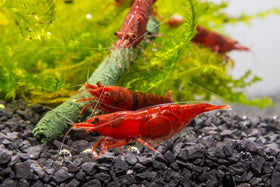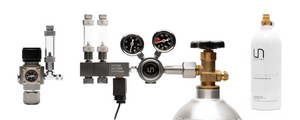
Benefits of Live Plants for Breeding Fish/Shrimp
Breeding fish and shrimp is considered one of the most fulfilling parts of the aquarium hobby. To be able to see a bunch of baby fish or shrimp growing up in your tank and knowing you had a part to play in it can be very rewarding. As someone that has bred a few species of fish and shrimp, there’s one particular thing I find myself almost always implementing in my breeding set-ups: live aquatic plants.
Whether you have livebearers like guppies, egg-scattering fish such as tetras, or egg-layers like angelfish, live plants in the aquarium can benefit fish/shrimp breeding in a multitude of ways. While plants are not exactly necessary when it comes to breeding these aquatic animals, this article will explain the reasons why keeping live plants in a breeding set-up could give a significant advantage in successfully breeding fish and shrimp.

An Amano & Fire Cherry Red shrimp hanging out
Plants Are a Natural Filter
When it comes to breeding fish and shrimp, an important step in the process is conditioning the breeders. This often involves heavy feedings to condition them into the breeding mood. Raising fry also involves frequent feedings. Baby fish have a high metabolism and digest their food a lot faster than adults because they’re growing! Breeders will feed them at least two to four times a day to make sure the fry are growing nice and healthy.
In general, breeding fish and shrimp usually involves a lot of feeding, and a lot of feeding leads to a large amount of waste being built up in the aquarium. In this case, waste refers to poop and uneaten food. All of this waste will inevitably release ammonia into the water. Ammonia is toxic to both fish and shrimp, but in a cycled aquarium it converts into nitrites and then nitrates, which is tolerable at low amounts for most aquatic species. This is why it’s important to have a cycled tank! (Click here for more information on cycling your tank.)

It’s also important for aquarists to keep up with water changes in order to keep the nitrate level as low as possible in the tank. (Click here for more info on the importance of water changes.) Yet in a planted tank, it is recommended to keep around 20ppm of nitrates in the water. This is because plants take in nitrates and other compounds in order to grow.
Tanks that are set up for breeding will quickly produce nitrate which can make it difficult to keep up with the necessary water changes. Good news! Live plants are a natural filter that can be a big help in removing nitrates from the aquarium water. The faster the plant grows, the more nitrates it will absorb.
Easy, fast-growing plants like Cabomba Aquatica and Water Wisteria are great for naturally filtering the aquarium. Floating plants such as Salvinia Natans or Water Lettuce are also highly recommended because they are considered some of the fastest growing aquatic plants that are naturally able to propagate themselves. They are low maintenance and simply require the removal of extra floaters when they become overcrowded
Replicate Your Fishy Friend’s Natural Habitat
In the wild, freshwater fish can be found in vast bodies of water with an abundance of space to swim in. These habitats typically have some fallen driftwood, rocks, and live plants, creating plenty of coverage for animals to hide in to avoid potential predators. Unfortunately for some baby fish, these potential predators might even include their own parents. Although, fry have a good chance of surviving into adulthood without becoming a snack for larger fish when in these large bodies of water with generous amounts of coverage.
Compared to a lake, aquarium hobbyists keep and raise their fish and shrimp in tanks or other containers that are monumentally smaller. The tank’s livestock have less space to roam, and depending on how the aquarium is decorated, also less areas to hide.
This can prove to be a problem for aquarists interested in breeding. The adult fish may feel unsafe and as a result not breed. For those fish that do breed, it is likely the eggs or fry will be eaten (which is especially common in community tanks housing a lot of fish.)

Young 24k gold guppies swimming through some Bucephalandra and Anubias
You add more cover for your fish and shrimp by adding live plants. Some of the more aggressive fish may even start claiming territory now that more visual barriers exist. Generally, your fish will feel more comfortable in the aquarium knowing they have somewhere to hide when they feel that they’re in danger.
Fish are more likely to breed when they are comfortable. Adding live plants to your tank will add security and help with the process of breeding your fish. The increased amount of hiding places also gives baby fish and shrimplets a larger chance of surviving in the aquarium. They will be able to take shelter among the plants until they grow large and strong enough to venture out into more open areas of the aquarium.
Unfortunately, some hobbyists have trouble with fish that are considered “easy” to breed such as guppies because they run into the issue of cannibalism. Although, most of the fry should be able to survive and eventually start breeding themselves with an abundance of live plants in the tank.
Extra Source of Baby Food

Juvenile Asian rummynose (sawbwa resplendens) foraging for a potential snack in the Red Root Floaters
Like all living things, plants eventually break down. The decaying organic materials promote the growth of microorganisms (known as infusoria) that feed off bacteria. Many hobbyists who breed nano fish will have a culture of infusoria growing because of its microscopic size and nutritional value.
In addition, there are tiny creatures like copepods that can hitch a ride into your aquarium through newly added plants. These small crustaceans look like little white insects in the aquarium. They primarily feed on algae, bacteria, and detritus. Copepods are a great source of live food for fry and even small nano fish. Unfortunately, baby fish usually cannot rely solely on these microscopic creatures as a food source. Aquariums typically do not have a large enough colony of them in the tank. However, they make a great treat for them when they are hungry and waiting between feedings.

Blue Dream shrimp scavenging in moss
Plants also add more surface area for biofilm to grow on. Biofilm is an assortment of bacteria and other microscopic organisms living in a slime-like membrane that attaches to surfaces in the aquarium. This is a big source of food for shrimp, especially baby shrimp. It has been said that the more biofilm there is in a shrimp tank, the more success it will have with breeding. Check out SL-Aqua Vitality if you are looking to add more biofilm for your shrimp.
Moss is a great aquatic plant for biofilm to develop on. Moss can add an incredible amount of surface area for biofilm to attach to. It’s also great for shrimp to hang out in and pick through. Most mosses are easy to keep alive and grow, as they do not require high light.
If you want to succeed in breeding fish or shrimp, then make sure to pick up some plants for your aquascape! Check out our entire aquatic plant selection by clicking here.
Remember: Quarantining is IMPORTANT! Quarantining the plants and animals you plan to add will help prevent damage to your tank’s inhabitants. When it comes to adding new animals to your tank, you don't want to introduce any disease that the new comers may be carrying. Some fish may appear healthy when you buy them but can still be a carrier for a disease.
When it comes to plants, always quarantine or bleach your plants before adding them to a tank with livestock. Some plants you receive from suppliers may have pesticides or harmful pests. Click here to learn more about how to bleach dip your plants.
Tell us - Was this article helpful? Please leave a comment below!
If you have any questions regarding this article, please DM us on Instagram, Facebook, or email support@buceplant.com so we can assist you - @buceplant





Comments
Leave a comment